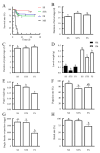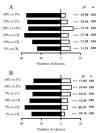Spodoptera frugiperda Uses Specific Volatiles to Assess Maize Development for Optimal Offspring Survival
- PMID: 40559022
- PMCID: PMC12193326
- DOI: 10.3390/insects16060592
Spodoptera frugiperda Uses Specific Volatiles to Assess Maize Development for Optimal Offspring Survival
Abstract
Spodoptera frugiperda, a major global agricultural pest, poses significant challenges to chemical control methods due to pesticide resistance and environmental concerns, underscoring the need for sustainable management strategies. Attractants based on host plant volatiles offer a promising eco-friendly approach, but their development for S. frugiperda is hindered by limited research on host recognition mechanisms. This study reveals that female S. frugiperda preferentially oviposit on maize at the seedling stage. Using electrophysiological techniques, we identified p-xylene and (+)-camphor from seedling-stage maize volatiles as key compounds eliciting strong responses in female S. frugiperda. Behavioral assays confirmed that these compounds (p-xylene at the concentration of 5%, 10%, and 20% and (+)-camphor at 1%, 5%, and 10%) significantly attract females, establishing them as the key odor cues for host selection. Moreover, these volatiles are more abundant in seedling-stage maize, suggesting that S. frugiperda assesses maize growth stages based on their concentrations. Importantly, larvae reared on seedling-stage maize exhibited higher survival rates than those on later-stage maize, indicating that oviposition site selection directly affects offspring fitness. These findings demonstrate that S. frugiperda uses p-xylene and (+)-camphor to evaluate maize development and select suitable oviposition sites, thereby enhancing larval survival. This study provides a foundation for developing targeted attractants for S. frugiperda and highlights the seedling stage as a critical period for implementing pest control measures, particularly in autumn maize production, given the higher pest population density during this phase.
Keywords: (+)-camphor; Spodoptera frugiperda; growth stage; host recognition mechanism; maize; p-xylene.
Conflict of interest statement
The authors declare that they have no conflicts of interest.
Figures










Similar articles
-
Differential Responses of the Egg-Larval Parasitoid Chelonus Bifoveolatus To Fall Armyworm-Induced and Constitutive Volatiles of Diverse Maize Genotypes.J Chem Ecol. 2025 Mar 12;51(2):34. doi: 10.1007/s10886-025-01585-3. J Chem Ecol. 2025. PMID: 40072721 Free PMC article.
-
Mycorrhizal fungus colonization on maize seedlings diminishes oviposition of fall armyworm females and affect larval performance.Environ Entomol. 2025 Jun 18;54(3):615-622. doi: 10.1093/ee/nvaf045. Environ Entomol. 2025. PMID: 40339063
-
Systemic pharmacological treatments for chronic plaque psoriasis: a network meta-analysis.Cochrane Database Syst Rev. 2021 Apr 19;4(4):CD011535. doi: 10.1002/14651858.CD011535.pub4. Cochrane Database Syst Rev. 2021. Update in: Cochrane Database Syst Rev. 2022 May 23;5:CD011535. doi: 10.1002/14651858.CD011535.pub5. PMID: 33871055 Free PMC article. Updated.
-
Comparative gene expression analysis of Beauveria bassiana against Spodoptera frugiperda.PeerJ. 2025 Jun 30;13:e19591. doi: 10.7717/peerj.19591. eCollection 2025. PeerJ. 2025. PMID: 40611938 Free PMC article.
-
Adefovir dipivoxil and pegylated interferon alfa-2a for the treatment of chronic hepatitis B: a systematic review and economic evaluation.Health Technol Assess. 2006 Aug;10(28):iii-iv, xi-xiv, 1-183. doi: 10.3310/hta10280. Health Technol Assess. 2006. PMID: 16904047
References
-
- Sparks A.N. A review of the biology of the fall armyworm. Fla. Entomol. 1979;62:82–87. doi: 10.2307/3494083. - DOI
-
- Sagar G.C., Aastha B., Laxman K. An introduction of fall armyworm (Spodoptera frugiperda) with management strategies: A review paper. Nippon J. Environ. Sci. 2020;1:1010. doi: 10.46266/njes.1010. - DOI
-
- Nagoshi R.N., Goergen G., Koffi D., Agboka K., Adjevi A.K.M., Du Plessis H., Berg J.V.D., Tepa-Yotto G.T., Winsou J.K., Meagher R.L., et al. Genetic studies of fall armyworm indicate a new introduction into Africa and identify limits to its migratory behavior. Sci. Rep. 2022;12:1941. doi: 10.1038/s41598-022-05781-z. - DOI - PMC - PubMed
-
- Maruthadurai R., Ramesh R. Occurrence, damage pattern and biology of fall armyworm, Spodoptera frugiperda (J.E. Smith) (Lepidoptera: Noctuidae) on fodder crops and green amaranth in Goa, India. Phytoparasitica. 2020;48:15–23. doi: 10.1007/s12600-019-00771-w. - DOI
-
- He L., Wu Q., Gao X., Wu K. Population life tables for the invasive fall armyworm, Spodoptera frugiperda fed on major oil crops planted in China. J. Integr. Agric. 2021;20:745–754. doi: 10.1016/S2095-3119(20)63274-9. - DOI
Grants and funding
LinkOut - more resources
Full Text Sources

